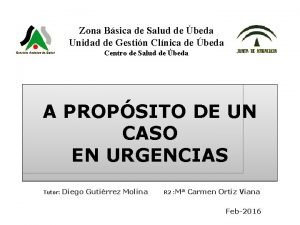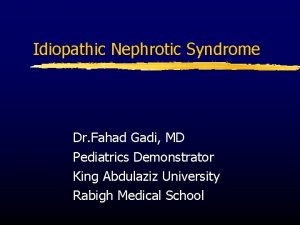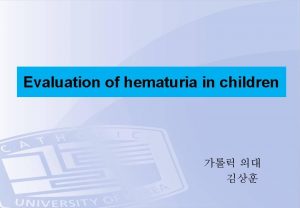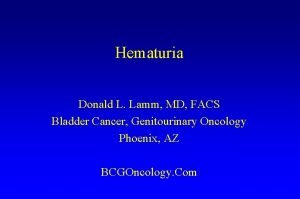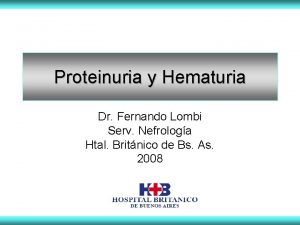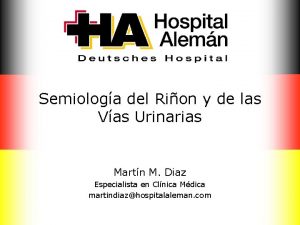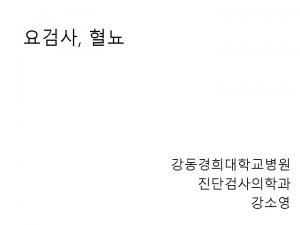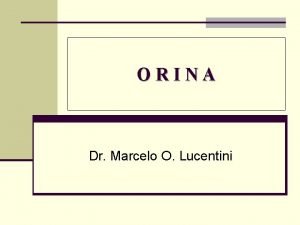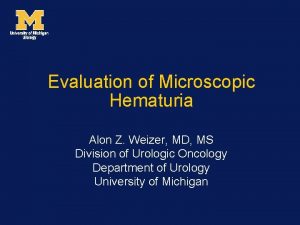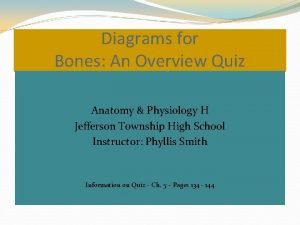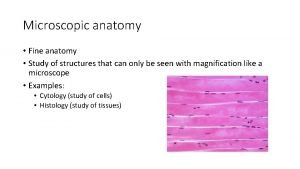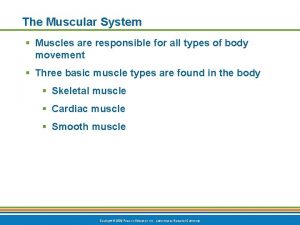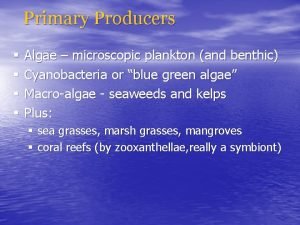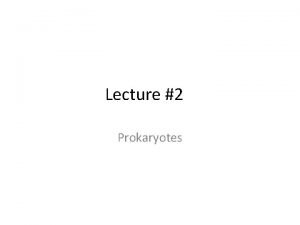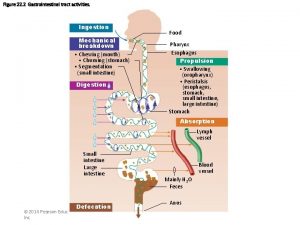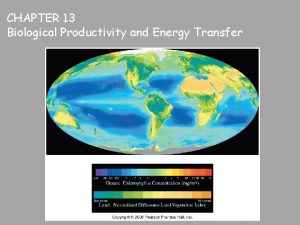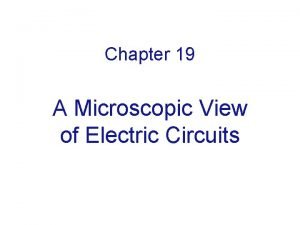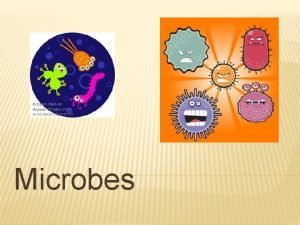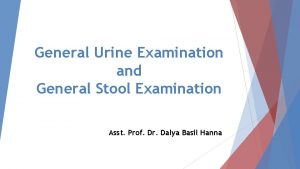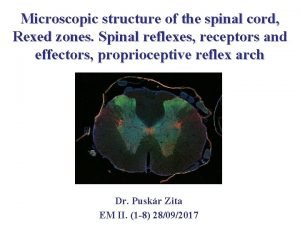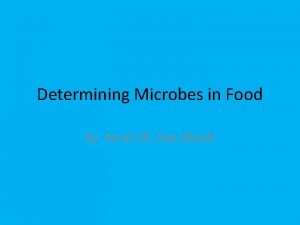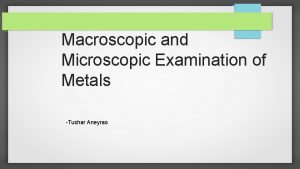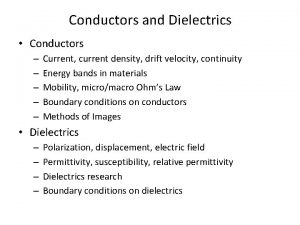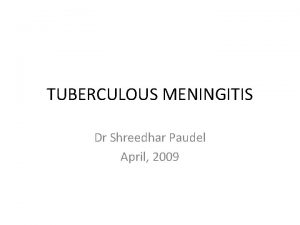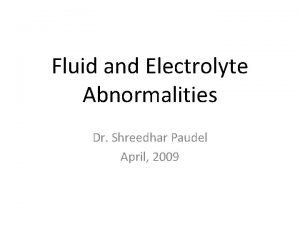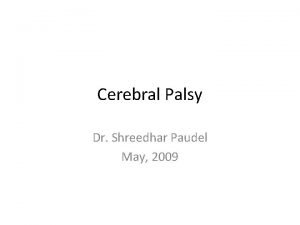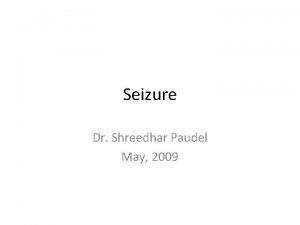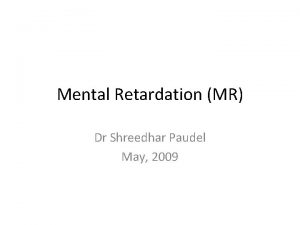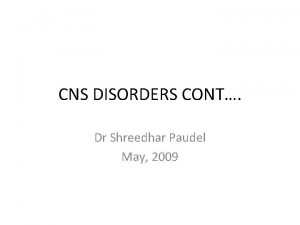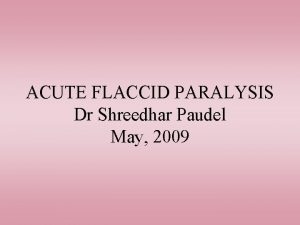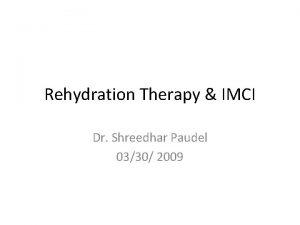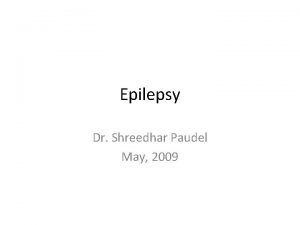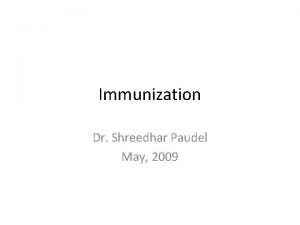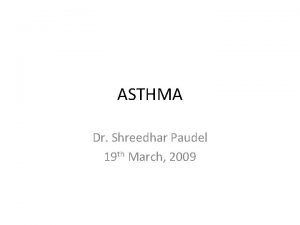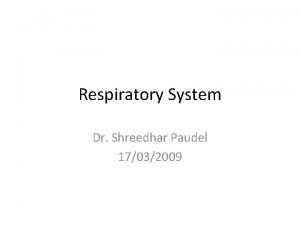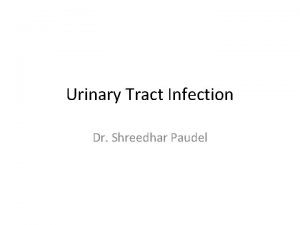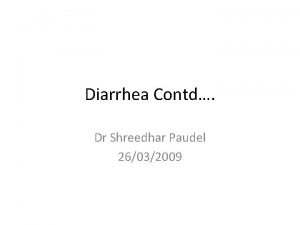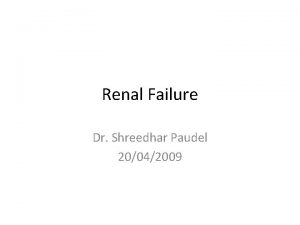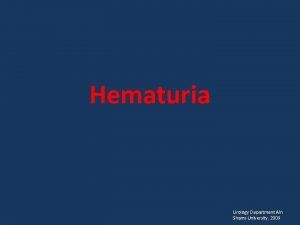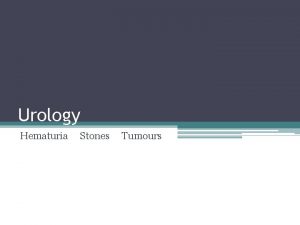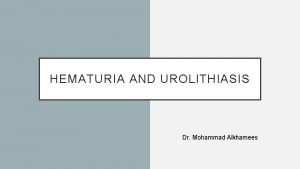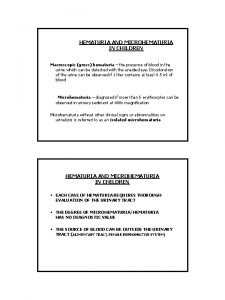HEMATURIA Dr Shreedhar Paudel April 2009 HEMATURIA Microscopic





























- Slides: 29

HEMATURIA Dr. Shreedhar Paudel April, 2009

HEMATURIA • Microscopic hematuria – more than three erythrocytes per high-power field • HEME-POSITIVE --Hemoglobin --Myoglobin

HEMATURIA……. . • Artificial food coloring – Beets – Berries – Chloroquine – Furazolidone – Hydroxychloroquine – Nitrofurantoin – Phenazopyridine – Phenolphthalein – Rifampin

HEMATURIA…. • CAUSES OF HEMATURIA: – A. RENAL • GLOMERULAR • RENOVASCULAR – B. HEMATOLOGICAL – C. URETERIC – D. PKCD, UTI, TUMOR

HEMATURIA…. . • CAUSES OF HEMATURIA: – Severe dehydration--- Renal vein thrombosis – Myocardial infarction-- Renal artery embolus or thrombus – Atrial fibrillation--- Renal artery embolus or thrombus – Hypertension Glomerulosclerosis-- with or without proteinuria

HEMATURIA……. . • EVALUATION OF PATIENT WITH HEMATURIA: – H/O passage of clots → extraglomerular cause of hematuria – H/O recent trauma to the abdomen → hydronephrosis – H/O early-morning periorbital puffiness, weight gain, oliguria, the presence of dark-colored urine, and the presence of edema or hypertension suggests a glomerular cause.

HEMATURIA……. . • EVALUATION OF PATIENT WITH HEMATURIA…. – Painless hematuria due to glomerular causes – H/O recent throat or skin infection → post infectious glomerulonephritis – H/O joint pains, skin rashes, and prolonged fever in adolescents → collagen vascular disorder

HEMATURIA……. . • EVALUATION OF PATIENT WITH HEMATURIA…. – The presence of anemia cannot be accounted for by hematuria alone → in a patient with hematuria and pallor, other conditions such as systemic lupus erythematosus and bleeding diathesis should be considered – H/O fever, abdominal pain, dysuria, frequency, and recent enuresis in older children → UTI as the cause of hematuria

HEMATURIA……. . • EVALUATION OF PATIENT WITH HEMATURIA…. – Skin rashes and arthritis → HSP and SLE – Information regarding exercise, menstruation, recent bladder catheterization, intake of certain drugs or toxic substances, or passage of a calculus may also assist in the differential diagnoses.

HEMATURIA……. . • EVALUATION OF PATIENT WITH HEMATURIA…. – familial, Alport syndrome, collagen vascular diseases, urolithiasis, or PCKD – PHYSICAL EXAMINATION – INVESTIGATION

HEMATURIA……. . ØIndications of kidney biopsy in patients with hematuria: • Significant proteinuria • Abnormal renal function • Recurrent persistent hematuria. • Serologic abnormalities (abnormal complement, ANA, or ds. DNA levels). • Recurrent gross hematuria. • A family history of end-stage renal disease

ACUTE GLOMERULNEPHRITIS (AGN) • CONDITIONS PRESENTING AS AGN – POST INFECTIOUS—streptococci, hepatitis B and C, bacterial endocarditis – SYSTEMIC VASCULITIS – HSP, SLE, Polyarteritis nodosa – MEMBRANOPROLIFERATIVE GN – IGA NEPHROPATHY – ALPORT SYNDROME

Acute Poststreptococcal Glomerulonephritis • Sudden onset of – Gross hematuria – Edema – Hypertension – renal insufficiency • most common glomerular causes of gross hematuria in children

Acute Poststreptococcal Glomerulonephritis……… • Etiology: – throat or skin infection by certain “nephritogenic” strains of group A β-hemolytic streptococci. ↓ streptococcal pharyngitis (serotype 12) streptococcal skin infections or pyoderma (serotype 49)

Acute Poststreptococcal Glomerulonephritis……… • Pathology: – kidneys → symmetrically enlarged – light microscopy → enlarged glomeruli – Immunofluorescence → granular deposits of Ig. G – electron microscopy • Lumpy deposits on the subepithelial side of the capillary basement membrane

Acute Poststreptococcal Glomerulonephritis……… • Clinical Manifestations: – 5– 12 yr and uncommon before the age of 3 yr. – acute nephritic syndrome 1– 2 wk after an antecedent streptococcal pharyngitis or 3– 6 wk after a streptococcal pyoderma. – asymptomatic microscopic hematuria with normal renal function to acute renal failure

Acute Poststreptococcal Glomerulonephritis……… • Clinical Manifestations: Edema (puffiness around eyes and pedal edema) Hypertension Oliguria (cola colored urine) encephalopathy and/or heart failure owing to hypertension or hypervolemia – malaise, lethargy, abdominal or flank pain, and fever are common – –

Acute Poststreptococcal Glomerulonephritis……… • Clinical Manifestations: – The acute phase generally resolves within 6– 8 wk – urinary protein excretion and hypertension usually normalize by 4– 6 wk after onset – persistent microscopic hematuria may persist for 1– 2 yr after the initial presentation

Acute Poststreptococcal Glomerulonephritis……… • Diagnosis: – Urinalysis → • red blood cells (RBCs) • RBC casts • proteinuria(1+ to 2+) • polymorphonuclear leukocytes (indicative of glomerular inflammation) – mild normocytic anemia (due to hemodilution)

Acute Poststreptococcal Glomerulonephritis……… • Diagnosis: – ↓ed serum C 3 level – ↑ed antistreptolysin O (ASO) – ↑ ed serum urea and creatinine (reflecting degree of renal impairment)

Acute Poststreptococcal Glomerulonephritis……… Ø Complications: – – – – – Hypertension Acute renal dysfunction Hypertensive encephalopathy Heart failure Hyperkalemia Hyperphosphatemia Hypocalcemia Acidosis Seizures Uremia

Acute Poststreptococcal Glomerulonephritis……… • Treatment: – Patient with mild oliguria and normal BP → can be managed at home – Close monitoring of Blood pressure and dietary intake – 10 -day course of systemic antibiotic therapy with penicillin (once AGN occurred penicillin treatment has no effect on course of disease----may be given if active pharyngitis or pyoderma present)

Acute Poststreptococcal Glomerulonephritis……… • Treatment: – DIET • Protein, sodium and potassium restricted till serum urea reduce to normal and urinary output increases • Fluid intake restricted to amount equal to insensible loss + urinary loss • Overhydration-- ↑es HTN and precipitates LVF

Acute Poststreptococcal Glomerulonephritis……… • Treatment: – WEIGHT • Weighed daily • Should lose about 0. 5 % BW/ Day – due to endogenous catabolism • Gain in weight requires– fluid restriction – DIURETICS • Not indicated (since edema is rarely massive and comes to normal with return of renal function) • Used in presence of pulmonary edema (iv frusemide)

Acute Poststreptococcal Glomerulonephritis……… • Treatment: - – HTN • Mild—controlled by salt and water restriction • Malignant HTN – prompt treatment ( iv nitroprusside) – LVF • Control HTN • iv frusemide • Prognosis: – Complete recovery occurs in 95% of cases

Henoch-Schönlein Purpura • Small vessel vasculitis • Mild renal involvement– microscopic hematuria, mild proteinuria • Clinical features: – purpuric rash ( extensor surface) – Arthritis – abdominal pain – Rarely presents with nephritic or nephrotic syndrome, HTN, azotemia

Henoch-Schönlein Purpura…

Henoch-Schönlein Purpura…

Henoch-Schönlein Purpura…. • TREATMENT: – Most patients recover without any specific treatment – Long-term observation– to detect insidious renal damage – Combination of steroids and azathioprine recommended – But long-term outcome may not be satisfactory
 Sunil paudel
Sunil paudel Institutional calendar
Institutional calendar Oxibutinina dosis
Oxibutinina dosis Fountain valley hematuria
Fountain valley hematuria Hematuria causes
Hematuria causes Dr donald lamm
Dr donald lamm Hematuria glomerular y extraglomerular
Hematuria glomerular y extraglomerular Anuria disuria poliuria oliguria hematuria
Anuria disuria poliuria oliguria hematuria Hemoglobinuria vs hematuria
Hemoglobinuria vs hematuria Hematuria
Hematuria Oxalato de calcio
Oxalato de calcio Macroscopic hematuria causes
Macroscopic hematuria causes Hematuria
Hematuria Microscopic images quiz
Microscopic images quiz Microscopic anatomy example
Microscopic anatomy example Microscopic anatomy of skeletal muscle figure 6-2
Microscopic anatomy of skeletal muscle figure 6-2 Microscopic producers
Microscopic producers Resistivity
Resistivity Microscopic single celled prokaryotes
Microscopic single celled prokaryotes Microscopic anatomy of stomach
Microscopic anatomy of stomach Microscopic transistor
Microscopic transistor Biological productivity examples
Biological productivity examples Microscopic view of electric current
Microscopic view of electric current Microscopic organism definition
Microscopic organism definition Cast in stool microscopy
Cast in stool microscopy Muscle spindle histology
Muscle spindle histology Direct microscopic count
Direct microscopic count Microscopic examination of metals
Microscopic examination of metals Dorsifelxion
Dorsifelxion Ohm's law microscopic form
Ohm's law microscopic form


